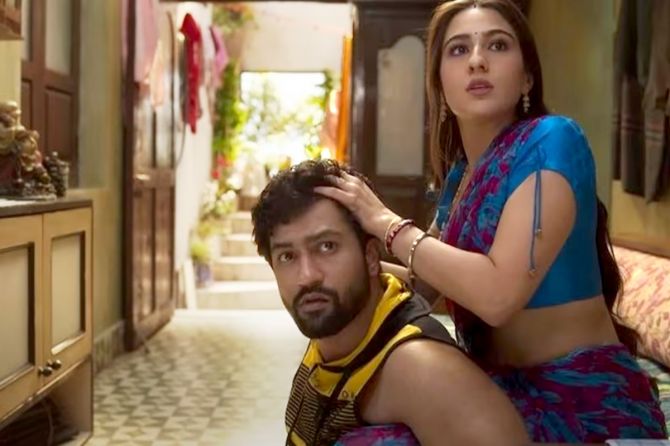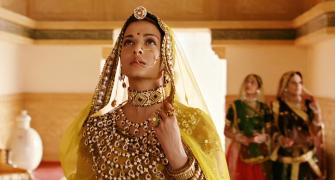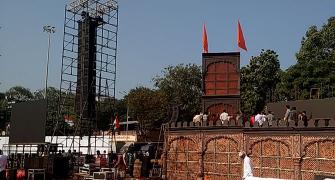'At a time when there's a lot of conversation happening around how AI has made art directors and production designers jobless, we will simply say that if your work speaks for you, you will never be out of work.'

Nitin Chandrakant Desai's shocking suicide has turned the spotlight on art direction and production design.
Many insist that technology -- chroma screen and Artificial Intelligence -- coupled with the after-effects of the COVID-19 pandemic that crippled the economy across the world, led to budgets shrinking in Hindi films and is putting technicians out of business.
Rediff.com Senior Contributor Roshmila Bhattacharya speaks to National Award-winning art directors and production designers, Amit Ray and Subrata Chakraborty, who insists that it is the focus on money that is affecting not just the work culture, but also the quality of work today.
"We have already built over 60 sets for Sanjay Leela Bhansali sir's Web series Heera Mandi, which will raise the bar for OTT, and the work continues. Dada, our mentor Samir Chanda, always said, that once your work is appreciated, money will come automatically. He was right. We may not own an Audi or a Mercedes, but we have never been short of work," they assert.
Vishalji was the only one to entrust us with a film after Dada's demise

It was a decade ago that Subrata (Chakraborty) and my partnership was forged, brought on by the sudden demise of Dada (their mentor art director and production designer Sameer Chanda) whose table, till the last day, was piled high with at least 20 scripts of top film-makers.
After assisting Dada for 11 years, we were suddenly left bereft and adrift in Bollywood.
We approached many directors for work, but it was only Vishal Bhardwajji who entrusted us with a big budget, much-coveted, project, Matru Ki Bijlee Ka Mandola.
That was in 2013, and since then, we have worked with Vishalji, who loves us like his own sons, on Dedh Ishqiya, Haider, Talvar, Rangoon and more recently on his son Asmaan's directorial debut Kuttey.
Haider was a challenge because back then, Kashmir was infested with terrorists. But as Vishalji pointed out, 'Chhoti si zindagi hai aur aaj nahin to kal marna hi hai (Life is short and we all have to die today or tomorrow)', but if you do some good work, people will remember you by it.
So, off we went to the Valley, to build sets and set them on fire before the snow came.
We accepted Nitesh Tiwari's Ramayan to learn visual effects from Hollywood technicians

Rangoon was an even bigger challenge because it was set during the Second World War and shot in Arunachal Pradesh where crowds of stargazers made shooting difficult.
We put the skills we had learnt from Dada during Guru to good use, masking a train from today's time, to pass it off as one from the 1940s, for Kangana Ranuat's Julia to travel in with her performing troupe to the war-torn Burma border.
The interiors of the train and the song were shot on a set in Mumbai's Film City studio.
Could money, time and effort have been saved had we shot against a chroma screen?
Maybe, and we did use technology for the first time in Rangoon, making miniature sets for some scenes, which were then magnified by visual effects.
It's a technique Hollywood has perfected, but very few technicians in India have mastered it.
That's why we have accepted Nitesh Tiwari's Ramayan to learn how to use visual effects effectively from Hollywood technicians.
It's not as simple as one imagines, and expensive too.
It's better to build the foreground and the background and use a chroma screen to show the third ground

If you watch them on the big screen, you will notice the difference between Padmaavat, which is 90 percent sets, and two phenomenal Baahubali films, which have used a lot of visual effects, but these sets don't look as real as ours.
It's better to build the foreground and the background and use a chroma screen to show the third ground which would be the view from the window, creating the Alps without going to Switzerland.
At a time when there's a lot of conversation happening around how AI (Artificial Intelligence) has made art directors and production designers redundant and jobless, we will simply say that if your work speaks for you, you will never be out of work.
We have already built over 60 sets for Sanjay Leela Bhansali sir's Web series Heera Mandi, which will raise the bar for OTT, and the work continues.
Many agents have entered the field for whom production design is not art or passion, but business.

I (Amit Ray) quit a high-paying advertising job in Kolkata, coming to Mumbai with one suitcase, to join Dada's team and learn on the job.
For three years, I earned just enough to survive in this city.
Occasionally, after working on a big film like Rang De Basanti, Dada would send Subrata and me to work on a small budget film with Buddadeb Dasgupta or Gautam Ghose, telling us we would learn from them and also earn goodwill.
I got my first remuneration only after three years for my work in Shyam Benegal's Netaji Subhas Chandra Bose: The Forgotten Hero.
Dada always said, once your work is appreciated, money will come automatically.
He was right. We may not own an Audi or a Mercedes, but we have never been short of work.
But today, our assistants want to know on the second day itself how much they will be paid.
Many agents have entered the field who sweet talk big film-makers with their proficiency in English.
For them, production design is not art or passion, but business.
They are in this to make money.
But at the end of the day, your work speaks for you.
Ramayan was being done by someone else, but after a year, when this person made a presentation, the makers were not impressed.
That's when we got a call that Nitesh sir (Tiwari) wanted to meet us.
He jumped on seeing our first design, saying excitedly, 'This is what I want!'
Eventually, quality rules.
We won the National Award for 24, but no awards for Padmavat

The generation before ours, be it Dada, Nitish Roy or Sharmistha Roy, were driven by a quest for perfection and grandeur.
Even the late Nitin Chandrakant Desai from our generation made an impact with historicals like Lagaan and Jodha Akbar and period dramas like Devdas.
As Dada's disciples, we belong to the same gharana and live by his conviction and motivation.
We don't accept shows or other work apart from film, television or OTT.
We may not have crores in the bank, but we are proud recipients of the National Award for Suriya's Tamil, sci-fi action film 24.
Gangubai Kathiawadi also won us many awards, including the Filmfare statuette, but to our disappointment, Padmavat didn't and hardly anyone has seen one of our best films, Hawaizaada.
We were working even during the pandemic, on Bellbottom andSamrat Prithviraj

The COVID-19 pandemic brought the country to a standstill.
We were also affected, but then Akshay (Kumar) came to us wondering if it would be wise to venture abroad and shoot Bellbottom.
We told him what Vishalji had told us all those years ago, pointing out that we could die in Mumbai sitting in our homes, at least in the UK and Scotland there are fewer people.
We flew to Budapest, quarantined ourselves for 10 days there, then drove down, taking another flight to reach the location where we stayed in a bio-bubble for a month and completed Bellbottom.
It was a difficult time, but at the same time, great fun. We all lived and worked together under one roof.
We also worked on Samrat Prithviraj, another Akshay Kumar starrer, during the pandemic, putting up sets in Jaipur.
Choti si zindagi hai, you can't live it by being afraid.
We surprised Rajkumar Hirani by building a Punjab village in Film City

Since the pandemic, there are fewer big projects because it's harder to draw the audience to the theatres now.
But give them a good film, something different, and people will come.
Pathaan proved that, so did RRR.
Gangubhai Kathiawadi rode on the shoulders of a young girl (Alia Bhatt), a brilliant film-maker (Sanjay Leela Bhansali) and a great script.
Laxman Utekar's sir's Zara Hatke Zara Bachke did extremely well.
Would you believe that the exteriors of Vicky (Kaushal) and Sara's (Ali Khan) house in the film were shot in Indore, but the interiors were built here in Mumbai by us?
Of late, film-makers prefer shooting on location, in real bungalows, as it is less expensive than putting up a set in a studio.
Recently, when working with Raju sir (Rajkumar Hirani) for the first time on the Shah Rukh Khan starrer Dunki, he shared that he needed a village in Punjab but did not have the budget to build a set.
Money has never been a deterrent for us, and we surprised him by building him one in Film City in Mumbai.
He was thrilled that we did not give up and called Vidhu sir (Producer Vidhu Vinod Chopra) for a dekko.
He came past midnight, spent an hour-and-a-half inspecting every corner of the sprawling set and congratulated us warmly on a job well done.
That's our biggest reward, not the office we still don't have even after a decade in the industry or the Audi.
Atlee insisted we do his first production in Hindi while Laxman Utekar sir has signed us for his historical Chhawa.
That's what gives us confidence that no matter how big the tempests, by being the 'eye of the director', we will survive in this wonderland.








